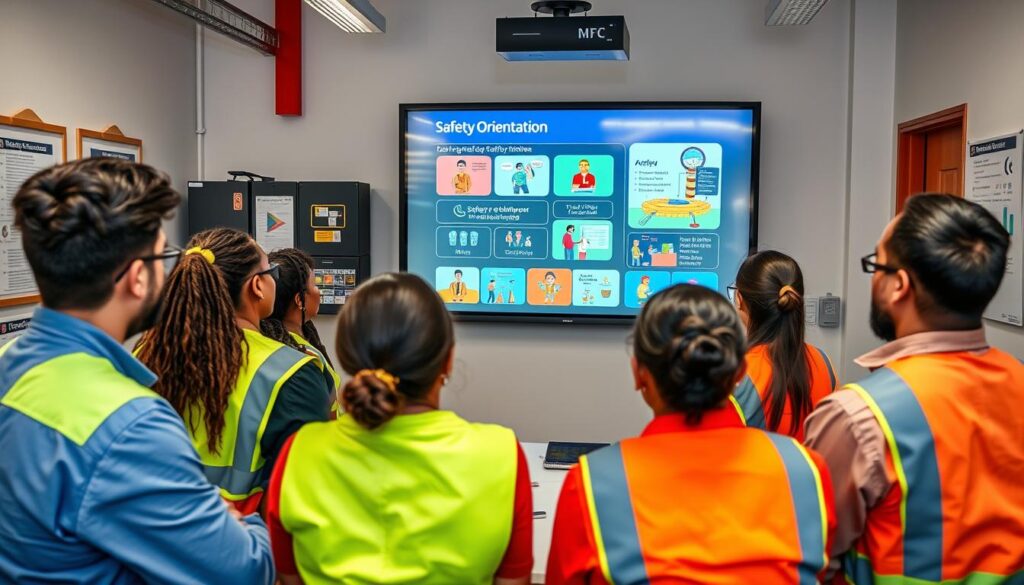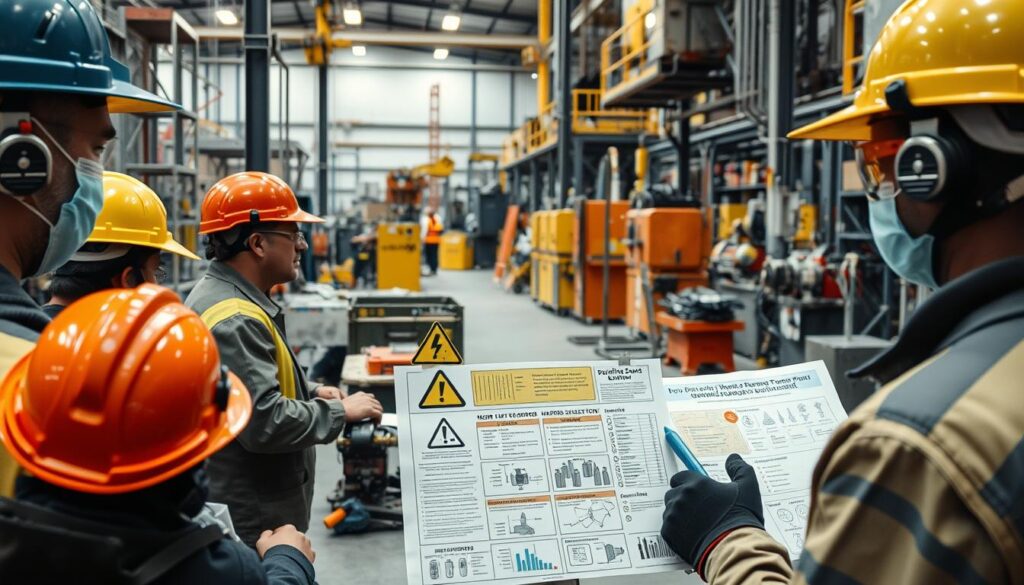I’m eager to lead you through crafting effective safety orientation videos for new employees. Safety orientation is vital in the onboarding process. It ensures new hires grasp workplace hazards, safety protocols, and their part in maintaining a safe work environment.
Videos can make learning engaging and interactive, enhancing employee retention and fostering a safety culture.

This article explores the significance of safety orientation and outlines key elements for effective videos. It also offers practical tips for incorporating these visual aids into your onboarding. Whether your business is small or large, this guide will equip you to create captivating safety orientation videos.
These videos will engage your new employees, increase risk awareness, and ensure compliance with industry standards.
Importance of Safety Orientation for New Hires
Effective safety orientation for new employees is crucial for several reasons. It significantly reduces the risk of workplace incidents and accidents. This is achieved by ensuring employees are aware of potential hazards and know how to respond. It safeguards workers’ well-being and helps comply with safety regulations, reducing the organization’s liability.
Reducing Workplace Incidents
According to Legislative new hires face a higher risk of workplace injuries or incidents in their first year. Comprehensive safety orientation programs can mitigate this risk. They provide thorough training on safe work practices, emergency procedures, and the proper use of personal protective equipment (PPE).
Promoting a Culture of Safety
Safety orientation is key in promoting a culture of safety within an organization. Empowering new employees with the knowledge and tools to prioritize their safety and that of their colleagues encourages them to maintain a safe work environment. This fosters a shared sense of responsibility and accountability, leading to a stronger safety-conscious mindset among all team members.
Investing in effective safety orientation programs for new hires reduces workplace incidents and builds a safety-conscious culture. This benefits employees and contributes to the long-term success and sustainability of the business.
A safe workplace is not just a legal requirement – it’s a fundamental right of every employee. Effective safety orientation is the cornerstone of building a culture that truly prioritizes the well-being of our workforce.
Key Elements of Effective Safety Orientation Videos
Creating impactful safety orientation videos for new employees involves several key elements. These videos should aim to engage and educate, not just convey information. They should use interactive multimedia, clear compliance explanations, and visually appealing aids.
One main goal of these videos is to boost employee engagement and reinforce learning. To do this, they should include interactive elements like animations, simulations, and quizzes. These features make learning fun and help employees remember important safety information.
Additionally, the videos must clearly outline compliance regulations and preventive measures. Visual aids like infographics and diagrams are effective in communicating these details. They ensure employees understand their role in keeping the workplace safe.
| Key Element | Description | Benefits |
| Interactive Multimedia | Animations, simulations, and quizzes | Increased employee engagement and reinforced learning |
| Compliance Regulations | Clear explanations of relevant safety rules and policies | Improved understanding of employee responsibilities |
| Visual Learning Aids | Infographics, diagrams, and other visual elements | Enhanced comprehension and retention of safety information |
By including these elements in safety orientation videos, employers can offer an engaging and informative experience. This promotes a strong safety and compliance culture within the organization.

Identifying Potential Hazards and Risks
Ensuring workplace safety starts with spotting potential hazards and risks. Safety orientation videos should highlight the need for a detailed workplace hazard assessment. This helps identify specific threats and vulnerabilities in the work environment. Understanding these risks allows employees to apply risk mitigation strategies to prevent incidents and safeguard themselves and their colleagues.
Workplace Hazard Assessment
A thorough hazard assessment is vital for a safe workplace. It involves a careful examination of the work environment to pinpoint potential dangers. These can include:
- Slip, trip, and fall hazards
- Exposure to harmful chemicals or materials
- Ergonomic issues like improper workstation setup
- Electrical or fire risks
- Machinery and equipment-related hazards
Risk Mitigation Strategies
After identifying hazards, the next step is to put in place effective risk mitigation strategies. These strategies aim to reduce the chance of incidents and protect employees. They may involve:
- Setting up clear safety protocols and procedures
- Providing the right personal protective equipment (PPE)
- Using engineering controls, like guarding or ventilation systems
- Hosting regular safety training and drills
- Ensuring adherence to relevant compliance regulations
By actively identifying and tackling potential hazards, organizations can foster a safer work environment. This empowers employees to contribute to a culture of safety.

Engaging Visual Storytelling Techniques
Effective safety orientation videos should use engaging visual storytelling techniques to grab the audience’s attention. This method helps create compelling narratives that connect with employees. It makes learning more memorable and impactful.
Multimedia Elements for Better Retention
Adding multimedia elements like dynamic graphics, animated sequences, and real-world scenarios boosts the learning experience. These elements make safety concepts more engaging and interactive. They encourage employees to engage actively with the content.
Interactive quizzes and simulations also improve retention. They challenge learners to apply their knowledge, deepening their understanding of safety protocols and procedures.
| Visual Storytelling Techniques | Multimedia Elements |
| Dynamic graphicsAnimated sequencesReal-world scenarios | Interactive quizzesImmersive simulationsEngaging video content |
Using these visual learning aids and interactive learning methods, safety orientation videos can effectively engage new employees. They promote a deeper understanding of critical safety protocols. This leads to better employee retention and a stronger culture of safety in the organization.
Incorporating multimedia elements and visual storytelling techniques into safety orientation videos can significantly enhance employee engagement and knowledge retention.
Integrating Safety Videos into the Onboarding Process
To maximize the impact of safety orientation videos, they must be seamlessly integrated into the onboarding process. This involves combining traditional training methods, like in-person demonstrations and hands-on practice, with digital learning resources.
By doing so, organizations can create a comprehensive training program. This ensures new employees receive the necessary information and support to maintain a safe work environment.
Blending Traditional and Digital Training Methods
Combining traditional training techniques with innovative digital tools offers a well-rounded onboarding experience. This hybrid approach leverages the strengths of both methods. It ensures new employees are engaged, informed, and equipped to navigate the workplace safely.
- In-person safety demonstrations and workshops provide hands-on learning opportunities. They allow new hires to practice essential safety protocols and receive immediate feedback.
- Safety orientation videos complement these traditional methods. They offer an engaging, multimedia-driven learning experience accessible at the employee’s convenience.
- This blend enhances overall employee engagement, knowledge retention, and compliance with relevant safety regulations.
By integrating safety videos into the onboarding process, organizations can create a seamless and comprehensive training program. This program fosters a culture of safety and employee well-being from the start.
Effective safety orientation is not just about compliance – it’s about empowering employees to be active participants in maintaining a safe workplace
Measuring the Impact of Safety Orientation Videos
Evaluating the impact of safety orientation videos is crucial for driving continuous improvement. It ensures the training program meets the organization’s safety goals. By tracking key metrics, companies gain valuable insights to enhance their safety orientation videos and onboarding process.
One important metric to monitor is employee engagement. Analyzing employee feedback and participation levels shows how well the videos resonate. It indicates if new hires find the content informative and engaging. This data helps optimize video content, format, and delivery methods.
Another critical measure is safety compliance. Tracking the adoption of safe practices and adherence to safety protocols is key. It shows the effectiveness of the videos in reinforcing safety awareness and risk mitigation strategies. Continuous monitoring guides refinements to the training program.
Assessing risk awareness is also essential. Evaluating new hires’ understanding of workplace hazards and their ability to identify and address risks is crucial. It determines the impact of the safety orientation videos in fostering a culture of safety and risk prevention.
The ultimate goal is to leverage insights from measuring safety orientation video impact for continuous improvement. This enables companies to enhance the training program, address gaps, and ensure new employees prioritize safety in their work.
By prioritizing the measurement and analysis of safety orientation video impact, organizations make informed decisions. They foster a safer work environment and empower their workforce. This empowers them to be active participants in the journey towards a culture of safety and continuous improvement.
Conclusion
Creating effective safety orientation videos for new employees is crucial for a comprehensive safety training program. These videos use engaging visual storytelling and interactive multimedia. They focus on key safety information, empowering the workforce and promoting a safety culture. This ensures compliance with relevant regulations.
By integrating these videos into the onboarding process, businesses can foster a safer work environment. Continuous measurement of these videos’ impact drives long-term success. This approach is essential for ensuring a safe and productive workplace.
Effective safety orientation videos give new hires the knowledge to identify hazards and mitigate risks. They learn to adopt safe work practices. This reduces workplace incidents and fosters a shared commitment to safety among employees.
By blending traditional and digital training methods, organizations create an engaging onboarding experience. This resonates with the modern workforce. It prepares employees for a safer, more productive, and resilient work environment.
Investing in high-quality safety orientation videos is a strategic step for companies. It sets the stage for long-term success and safeguards valuable assets – the people. Prioritizing employees through these videos is essential for a company’s future.
